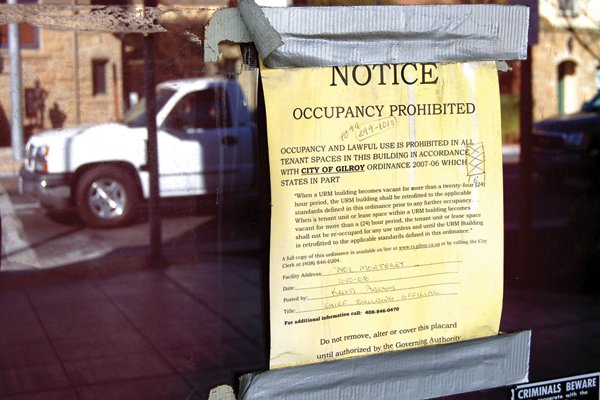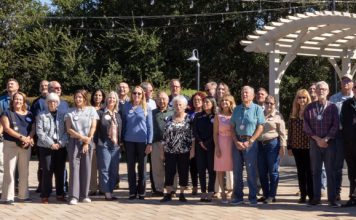When Gilroy City Councilman Bob Dillon drives downtown for
lunch, the sight of boarded, empty buildings is almost enough to
make him lose his appetite. He said the city, which recently passed
a new retrofit ordinance, needed to expedite efforts to repair the
URMs
– in terms of safety and cosmetics. Even if the city has to lend
its own money, Dillon said.
When Gilroy City Councilman Bob Dillon drives downtown for lunch, the sight of boarded, empty buildings is almost enough to make him lose his appetite.
“I’m tired of looking at them,” Dillon said, referring to dozens of unreinforced masonry structures that cannot reopen until they meet seismic safety guidelines. He said the city, which recently asked staff to a prepare new retrofit ordinance, needed to expedite efforts to repair the URMs – in terms of safety and cosmetics.
Even if the city has to lend its own money, Dillon said.
“Somebody’s going to die here,” Dillon said. “And in addition, (the buildings are) ugly as hell.”
The City Council on Feb. 7 directed city staff to draft a new ordinance which would require property owners to pay for life safety retrofits instead of full retrofits, which were mandated by a previous ordinance. Building owners were also originally scheduled to be fined $10,000 per month for failing to begin the retrofitting process. In December, the city extended the deadline for beginning the retrofit process to June 30, 2011.
The new ordinance would be the latest step in downtown’s retrofitting saga, which has forced the city to cultivate possible solutions and sparked differing opinions from Council members over the past few years.
Before passing the motion by a 7-0 vote, Council members tossed around the idea of the city lending money to property owners to hopefully speed up the purchase of mandatory retrofits to allow those buildings to reopen.
Life safety retrofits – which could cost approximately $25,000 to $50,000 for a typical 2,000-square foot building in Gilroy – pay for bracing parapets, securing roofs to walls and preventing any hanging ornamentation from falling during an earthquake, local developer Gary Walton said. That cost is roughly 10 percent of what a full retrofit would cost, he said.
Kristi Abrams, community development director, said during the Feb. 7 Council meeting that there were currently 31 unoccupied URM addresses on 22 parcels downtown. Two URMs are city owned and will be demolished this calendar year, she added.
Lending money wouldn’t be a new thing for the city.
“We already do it,” Councilman Dion Bracco said.
Bracco referred to the city’s Homebuyer Assistance Program, in which the city can offer loans up to $50,000 to Gilroy residents and Gilroy Unified School District and city employees seeking to purchase a home in the city.
When it comes to downtown buildings, though, Mayor Al Pinheiro said the city should leave lending to the banks if at all possible.
“I have some real concerns about the city trying to do that on its own,” Pinheiro said. “At this point, I’m not sold on it one way or the other. My preference would be to find local banks and allow them to finance it themselves.”
The city’s URM task force met Jan. 13 with local representatives from nine banks to introduce ways lenders could finance downtown retrofits.
Lending money to downtown could make more work for city officials, Pinheiro added.
“We’d have to have staff monitoring payments and interest rates and all that,” Pinheiro said. “To me that’s the first negative.”
Pinheiro said the city would have future meetings with bank representatives to “discuss what they’ve come up with.”
Councilwoman Cat Tucker said she wanted “strong parameters” to accompany any potential city lending program. For example, Tucker said, the city could offer financial help to building owners for up to 12 months. After that, the city would pull back it’s helping hand, she said.
Under the new ordinance, the penalty for failing to complete a limited engineering analysis and building permit application within a year of the ordinance’s Feb. 7 passage could be set at $500 a month. Fines rise to $1,000 a month in the second year of the ordinance but are capped at $15,000 total. Property owners also wouldn’t have to pay for any additional retrofitting for 10 years – unless there was a change in use, or intensification of use in the building or if additions and modifications exceed 50 percent of the building’s value, Abrams said.
Abrams said the city anticipated to have the new ordinance in effect before June, though city Public Information Officer Joe Kline said the new ordinance likely wouldn’t take effect before then.
Bracco said he was confident most banks would be willing to lend now that the cost of mandatory retrofits have been greatly reduced.
“That’s how they make their money,” he said.
Bracco, who owns Bracco’s Towing and Transport, said he was in the process of purchasing new equipment for his company and banks were “fighting over themselves” to loan him money.
Even if the city did begin lending money to building owners, Bracco said he doubted the owners would take the city up on its offer.
“We’ll have to wait and see,” Bracco said. “We’ve tried program after program to try to help these folks to fix these buildings. Downtown has some unique challenges. I don’t think there’s any magic wand we can wave over downtown and fix things. It just takes time.”













